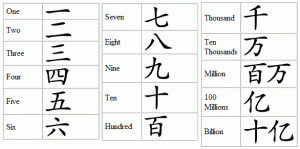Links: My post for Task 2; Jerry’s post for Task 2
I chose to link to Jerry’s post because we have the same native language (Chinese). For this “Does language shape the way we think?” task, I thought it would be interesting to find similarities and differences between two people’s ways of thinking, especially when they speak the same language.
Tools used
We’re both using WordPress on UBC Blogs, so the content-authoring capabilities for our sites should be similar. However, we’re using different themes, resulting in differences in the end-user interface. For example, Jerry’s background color is white and the text color is dark grey, while mine is reversed. Also, the text size for my theme is larger than Jerry’s, meaning my post would appear longer.
For this task, we both primarily used text to represent our reflection. In addition, Jerry inserted the original YouTube video, while I used several images to help explain my words.
Content
Themes we both discussed
1. Different cultures use different directions to represent time.
We both discussed how different language speakers use different directions to represent time. Jerry mentioned that “this was something new I learned from watching the speech” (Chen, 2023). Because of my psychology background, I knew this phenomenon before watching the video. In my post, I tried to find the relationships between traditional Mandarin handwriting (vertical writing) and Chinese speakers’ representation of time (using a vertical axis).
2. Our experience learning English as a second language.
We both used our experience learning English as our second language to relate to Dr. Boroditsky’s claim that language shapes people’s thinking (SAR School for Advanced Research, 2017). As multilingual learners, our ways of thinking have changed after speaking English most of the time every day.
3. Changing how people talk can change how people think.
We both agreed that learning a new language changed how we think. Jerry emphasized grammar confusion when speaking different languages, while I talked more about my changed value, which is more aligned with individualism now.
4. Language influences what people pay attention to and how people process information.
We both agreed that language use can change information processing and what people pay attention to. Jerry related to his teaching experience as he used different wording to emphasize more important content. I emphasized the way different language speakers describe events influences their following memory.
5. The number-counting system is different across different cultures.
We both mentioned the Chinese number-counting system, which differs from the Canadian one. I mentioned in my post that “Chinese number system is relatively straightforward, and the names for numbers are highly regular” (Wang, 2023). Jerry used hand counting as another example to show that even body language differs across cultures. Jerry mentioned using “a one-hand counting method for representing the first ten numbers, and the classmates and teachers were very confused” (Chen, 2023). 
New ideas from Jerry’s post
Jerry mentioned that Chinese standard greetings are asking whether you’ve eaten. I haven’t thought about this phenomenon when writing my post. Indeed, in China, people greet others by asking whether they have eaten breakfast, lunch, or dinner, depending on the time.
In Jerry’s post, he said that when he speaks Mandarin after using English the majority of the time every day, he sometimes uses incorrect grammar that would be correct in English. I highly emphasize Jerry’s experience. Moreover, I sometimes use English words when speaking Mandarin due to tip-of-the-tongue (failing to retrieve the corresponding Chinese words).
I appreciate Jerry’s idea that language is ever-changing and that new generations use existing words to mean new things. Due to cultural, technological, or societal changes, words often acquire new meanings over time. A representative example that came to my mind is the meaning of “6” in China. Its meaning changed from the original number six to an auspicious representation, then to modern Mandarin slang, which means “amazing, excellent, unbelievable, impressive.”
References
Chen, J. (2023, September 17). Task 2 | ETEC 540 – Jerry Chen. https://blogs.ubc.ca/etecjerrychen/2023/09/17/task-2/
SAR School for Advanced Research. (2017, June 7). Lera Boroditsky, how the languages we speak shape the way we think [Video]. YouTube.
Wang, B. (2023, September 9). Task 2: Does language shape the way we think? – Bingying (Iris) Wang-ETEC540. https://blogs.ubc.ca/etec540bingyingwang/2023/09/09/task-2-does-language-shape-the-way-we-think/


 For Chinese speakers, the overwhelming majority of writing follows the same direction as English speakers today. Vertical writing (from top to bottom in columns) is another standard format for written Chinese, especially for classical texts and calligraphy (Holdenje, 2023). The vertical format is still commonly used in traditional settings.
For Chinese speakers, the overwhelming majority of writing follows the same direction as English speakers today. Vertical writing (from top to bottom in columns) is another standard format for written Chinese, especially for classical texts and calligraphy (Holdenje, 2023). The vertical format is still commonly used in traditional settings.  For instance, the Chinese number system is relatively straightforward, and the names for numbers are highly regular, making it easier for Chinese learners to grasp basic numerical concepts at an early stage. According to Zhang et al. (2017), “language abilities were able to significantly predict both informal and formal math skills” for Chinese-speaking children (p.9).
For instance, the Chinese number system is relatively straightforward, and the names for numbers are highly regular, making it easier for Chinese learners to grasp basic numerical concepts at an early stage. According to Zhang et al. (2017), “language abilities were able to significantly predict both informal and formal math skills” for Chinese-speaking children (p.9).

 I imagine an archeologist aiming to understand this temporal period might view my items in a similar way as I view those equivalent things (as I mentioned above) from 15 years ago. The archeologist may think that many of my items have limited functions or can be combined into an integrated product. For example, tangible bank cards might be ousted completely; people only need online banking apps. I believe that as technology develops, items people carry daily in bags will become more integrated.
I imagine an archeologist aiming to understand this temporal period might view my items in a similar way as I view those equivalent things (as I mentioned above) from 15 years ago. The archeologist may think that many of my items have limited functions or can be combined into an integrated product. For example, tangible bank cards might be ousted completely; people only need online banking apps. I believe that as technology develops, items people carry daily in bags will become more integrated.